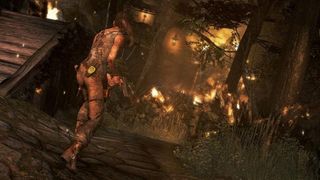Tomb Raider preview

Following “the first kill”, Tomb Raider temporarily becomes a third-person shooter without a cover mechanic. The shooting is enjoyable enough, but it feels thematically inappropriate. Meanwhile, many of the platforming sections feel rudimentary at best: graspable ledges are quite obviously signposted.
Still, this is early in the game, and directing Lara around the linear landscapes is pleasant enough. Occasionally she'll stumble across challenge tombs - little self-enclosed puzzles reminiscent of her roots - and happen upon journals sprinkled about the island to provide convenient context and spooks. Halfway through the session I'm tasked with scaling a radio tower that looms on the horizon to send a distress signal, which seems to promise the game's first truly breathtaking platforming challenge. I need to kill a bunch of guys to get there, but no worries - true platforming awaits!
“As an industry, I think we've only just touched the surface of our version of storytelling.” Horton says, again on the challenges of marrying gameplay with narrative. “We've been using traditional cinematics, something that's definitely borrowed from film. But what we've tried to do in this game, in addition to telling a story through cinematics, is to tell a story through play. As you're playing through the world there's visual storytelling going on everywhere, and there are conversations going on in context with gameplay. One of the powers of our medium is that you can have choice, and story, in addition to what we have to force through cinematics.

“There are certain things we have to get across," Horton continues. "But the things I'm more excited about with the medium is that we're able to do more visual storytelling and that sort of optional interactive storytelling that you can perceive when, instead of killing a dude [straight away] you can wait and listen to a conversation. you can get more of the fiction without being forced to stop and wait.”
The team's determination to tell a great story shines through in every part of the game, from the lovingly rendered jungles and their convincingly torrential weather systems, through to the seamless traversal of the world. No loading screens roam here, unless you die. Horton cites films like Children of Men and Apocalypse Now as inspiration for his art direction, films that “dealt with very horrific things, but dealt with them in a way that makes you feel you could have been there.”
So it's disappointing that after a protracted series of firefights and one or two short puzzles, I finally make the last victorious steps toward the radio tower... and the game takes control. What could have been a marvellous - transcendental - journey, turns into a cinematic.
Yes, it looks gorgeous, but I don't feel like I'm there . Which is a shame, because when it lets me play, Tomb Raider is pretty fun.
PC Gamer Newsletter
Sign up to get the best content of the week, and great gaming deals, as picked by the editors.
Shaun Prescott is the Australian editor of PC Gamer. With over ten years experience covering the games industry, his work has appeared on GamesRadar+, TechRadar, The Guardian, PLAY Magazine, the Sydney Morning Herald, and more. Specific interests include indie games, obscure Metroidvanias, speedrunning, experimental games and FPSs. He thinks Lulu by Metallica and Lou Reed is an all-time classic that will receive its due critical reappraisal one day.
Most Popular



